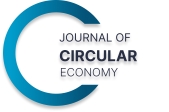Urban Digital Twins to achieve Blue Zones in a Circular Built Environment
Abstract
In our modern era, the “Blue Zones” concept represents regions inhabited by people with remarkable longevity, often reaching centenarian ages. In Europe, people spend 90% of their time in indoor environments. At the same time, the European Commission warns that indoor environments can be twice as unhealthy as outdoor spaces. The challenge lies in transforming buildings into metaphorical “blue” havens. Based on that, this perspective contemplates how the built environment can contribute to creating these desired Blue Zones, especially buildings and circular practices within the construction industry. Furthermore, it drives assumptions about Urban Digital Twins (UDTw), which target the Energy Performance of Buildings Directive (EPBD) and Smart Readiness Indicators (SRI). These assumptions intersect with crucial elements of circular construction within the European Union, including initiatives like the Green Deal (aiming for 55% emissions reduction) and the ambitious Renovation Wave (with plans to renovate 35 million buildings by 2030).
DOI: https://doi.org/10.55845/IYBO2513
References
Boje, C., Guerriero, A., Kubicki, S., & Rezgui, Y. (2020). Towards a semantic Construction Digital Twin: Directions for future research. Automation in Construction, 114, 103179. https://doi.org/10.1016/j.autcon.2020.103179
Boje, C., Hahn Menacho, Á. J., Marvuglia, A., Benetto, E., Kubicki, S., Schaubroeck, T., & Navarrete Gutiérrez, T. (2023). A framework using BIM and digital twins in facilitating LCSA for buildings. Journal of Building Engineering, 76, 107232. https://doi.org/10.1016/j.jobe.2023.107232
Calvetti, D., Kifokeris, D., Mêda, P., & Hjelseth, E. (2023, July 10). Human-data interaction in incremental digital twin construction. 2023 European Conference on Computing in Construction and the 40th International CIB W78 Conference. 2023 European Conference on Computing in Construction and the 40th International CIB W78 Conference. https://doi.org/10.35490/EC3.2023.276
Dan Buettner. (2023). Live to 100: Secrets of the Blue Zones. Netflix. https://www.netflix.com/pt-en/title/81214929
European Commission. (2010). Energy Performance of Buildings Directive—European Commission. European Commission. https://energy.ec.europa.eu/topics/energy-efficiency/energy-efficient-buildings/energy-performance-buildings-directive_en
European Commission. (2018). Smart readiness indicator—European Commission. European Commission. https://energy.ec.europa.eu/topics/energy-efficiency/energy-efficient-buildings/smart-readiness-indicator_en
European Commission. (2020). Renovation wave—European Commission. European Commission. https://energy.ec.europa.eu/topics/energy-efficiency/energy-efficient-buildings/renovation-wave_en
European Commission. (2021, July 14). Delivering the European Green Deal—European Commission. European Commission. https://commission.europa.eu/strategy-and-policy/priorities-2019-2024/european-green-deal/delivering-european-green-deal_en
European Commission – Press Release. (2003). Indoor air pollution: New EU research reveals higher risks than previously thought [Text]. European Commission. https://ec.europa.eu/commission/presscorner/detail/en/IP_03_1278
European Commission. Directorate General for Research and Innovation. (2021). Industry 5.0, a transformative vision for Europe: Governing systemic transformations towards a sustainable industry. Publications Office. https://data.europa.eu/doi/10.2777/17322
Fastame, M. C., Ruiu, M., & Mulas, I. (2022). Hedonic and Eudaimonic Well-Being in Late Adulthood: Lessons From Sardinia’s Blue Zone. Journal of Happiness Studies, 23(2), 713–726. https://doi.org/10.1007/s10902-021-00420-2
Ghufran, M., Khan, K. I. A., Ullah, F., Nasir, A. R., Al Alahmadi, A. A., Alzaed, A. N., & Alwetaishi, M. (2022). Circular Economy in the Construction Industry: A Step towards Sustainable Development. Buildings, 12(7), 1004. https://doi.org/10.3390/buildings12071004
Herbert, C., House, M., Dietzman, R., Climstein, M., Furness, J., & Kemp-Smith, K. (2022). Blue Zones: Centenarian Modes of Physical Activity: A Scoping Review. Journal of Population Ageing. https://doi.org/10.1007/s12062-022-09396-0
Marston, H. R., Niles-Yokum, K., & Silva, P. A. (2021). A Commentary on Blue Zones®: A Critical Review of Age-Friendly Environments in the 21st Century and Beyond. International Journal of Environmental Research and Public Health, 18(2), 837. https://doi.org/10.3390/ijerph18020837
Mêda, P., Calvetti, D., Hjelseth, E., & Sousa, H. (2021). Incremental Digital Twin Conceptualisations Targeting Data-Driven Circular Construction. Buildings, 11(11), 554. https://doi.org/10.3390/buildings11110554
Najafi, P., Mohammadi, M., Van Wesemael, P., & Le Blanc, P. M. (2023). A user-centred virtual city information model for inclusive community design: State-of-art. Cities, 134, 104203. https://doi.org/10.1016/j.cities.2023.104203
Sacks, R., Brilakis, I., Pikas, E., Xie, H. S., & Girolami, M. (2020). Construction with digital twin information systems. Data-Centric Engineering, 1, e14. https://doi.org/10.1017/dce.2020.16
Tchana, Y., Ducellier, G., & Remy, S. (2019). Designing a unique Digital Twin for linear infrastructures lifecycle management. Procedia CIRP, 84, 545–549. https://doi.org/10.1016/j.procir.2019.04.176
How to Cite This Article
Calvetti, D. (2024). Urban Digital Twins to Achieve Blue Zones in a Circular Built Environment. Journal of Circular Economy, 2(3). https://doi.org/10.55845/IYBO2513
Copyright
Open Access: This article is licensed under a Creative Commons Attribution 4.0 International License, which permits use, sharing, adaptation, distribution and reproduction in any medium or format, as long as you give appropriate credit to the original author(s) and the source, provide a link to the Creative Commons licence, and indicate if changes were made. The images or other third-party material in this article are included in the article’s Creative Commons licence, unless indicated otherwise in a credit line to the material. If material is not included in the article’s Creative Commons licence and your intended use is not permitted by statutory regulation or exceeds the permitted use, you will need to obtain permission directly from the copyright holder. To view a copy of this licence, visit http://creativecommons.org/licenses/by/4.0/.
Author Notes
Diego Calvetti[1]*
- [1] ICS/CONSTRUCT/Gequaltec, University of Porto Faculty of Engineering, Porto, Portugal
- *Corresponding author: [email protected]
Published Details: Received: 04.06.2024 / Accepted: 14.08.2024 / Published: 23.09.2024
